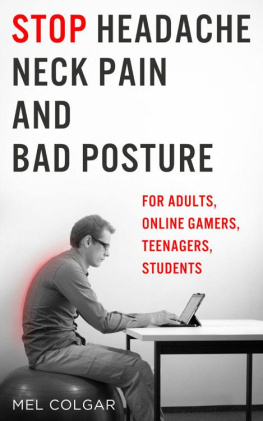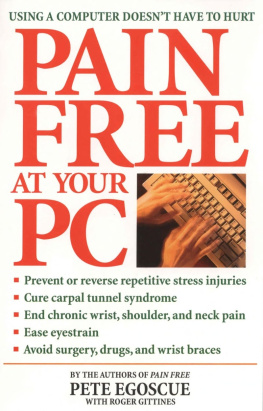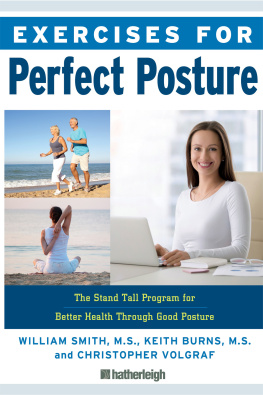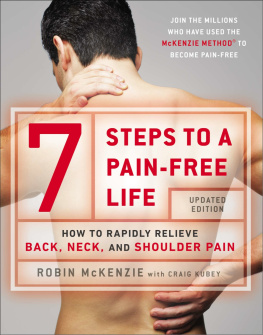Reverse Bad Posture Exercises
Fix Neck, Back & Shoulder Pain
in Just 15 Minutes per Day
Reverse Your Pain Series
Book 1
Morgan Sutherland, L.M.T.
Reverse Bad Posture Exercises
Fix Neck, Back & Shoulder Pain in Just 15 Minutes per Day
Reverse Your Pain Series Book 1
Copyright 2018 Morgan Sutherland
All rights reserved.
No part of this book may be reproduced in any form without permission in writing from the author. Reviewers may quote brief passages in reviews. The information contained in this book is current at the time of this writing. Although all attempts have been made to verify the information provided in this publication, neither the author nor the publisher assume any responsibility for errors, omissions, or contrary interpretations of the subject matter herein.
This book is for entertainment purposes only. The views expressed are those of the author alone and should not be taken as expert instruction or commands. The reader is responsible for his or her own actions.
At times links might be used to illustrate a point, technique, or best practice. These will reference products I have found useful, but please do your own research, make appropriate comparisons, and form your own decisions as to which products will work best for you. Links to products are used to illustrate points, because they are the examples with which I am most familiar.
Illustrations: Copyright Morgan Sutherland
Cover image: 123RF
Contents
Medical Disclaimer
The information provided in this book is not intended to be a substitute for professional medical advice, diagnosis, or treatment. Never disregard or delay seeking professional medical advice, because of something you read in this book. Never rely on information in this book in place of seeking professional medical advice.
Morgan Sutherland is not responsible or liable for any advice, course of treatment, diagnosis, other information, services, and/or products that you obtain in this book. You are encouraged to consult with your doctor or healthcare provider with regard to the information contained in this book. After reading this book, you are encouraged to review the information carefully with your professional healthcare provider.
Personal Disclaimer
I am not a doctor. The information I provide is based on my personal experiences and research as a licensed massage therapist. Any recommendations I make about posture, exercise, stretching, and massage should be discussed between you and your professional healthcare provider to prevent any risk to your health.
Introduction
Neglected postures, such as rounding your low back while sitting for extended periods of time in front of the computer, standing for hours stooped over, sleeping improperly, and lifting poorly, can all lead to chronic back pain.
Maintaining the natural lumbar curve in your low back is essential to preventing posture-related back pain. This natural curve works as a shock absorber, helping to distribute weight along the length of your spine.
Adjusting postural distortions can help stop back pain. A basic remedy to sitting all day is to simply get up! Frequently getting up from a seated position and doing specific, quick, and easy realignment exercises can help you reeducate your muscles from getting stuck in a concaved Cro-Magnon posture.
In todays culture, everyone seems to be constantly plugged into some device, be it a computer, laptop, tablet, or smartphone. Sedentary lifestyles inevitably result in thousands of hours spent with your body resembling a human question mark head jutting forward, shoulders are rounding, and stomachs getting closer to your knees.
The term Text Neck has been used time and time again to describe the repetitive-use injury that occurs to your upper back, neck muscles, forearms, wrists, and hands caused by a combination of poor posture, excessive texting, and smartphone use
One of the most common Text Neck symptoms is a crick in the neck and upper shoulders. This can develop from... over-stressing your neck muscles from excessive texting, awkward sleep positions , harshly twisting or turning your head during exercise, and from clocking hours of Quasimodo-like keyboard posture while hunching over your desk.
Did you know that for every inch the head moves forward in posture, it increases the weight of the head by a staggering 10 pounds? The average head weighs approximately 11 pounds. So, with that knowledge, when a head is held forward from the shoulders by only 3 inches, it causes approximately 43 pounds of pressure on the neck and upper back muscles.
Now thats a potential for a 43-pound headache . Yikes!
If you have Text Neck, then its also very likely that you have rounded shoulders .
Rounded shoulders cause your upper back muscles to overstretch and tighten the chest muscles. This posture can potentially compress the brachial plexus , the network of nerves that originate in the neck and feed into the armpit region and down into the arms. A brachial plexus impingement can lead to a number of problems, ranging from numbness in the hands to thoracic outlet syndrome or carpal tunnellike symptoms .
Prolonged Sitting and Back Pain
Sitting for too long causes your low back muscles and hip flexors (the muscles that allow you to lift your knees and bend at your waist) to become short and tight. Slumped over in a chair all day also makes your abdominal muscles slowly lose tone and your glutes (also known as the buttocks) to become overstretched and weak.
Another phenomenon that happens with prolonged sitting is that it causes an anterior (or front) tilt, which is an adaptive shortening of the hip flexor muscles. When moving from a prolonged sitting position to an upright one, the shortened hip flexors inevitably pull on the muscle attachments of the lumbar (low back) spine, causing an anterior shift in the hips. This can put unwanted strain on the low back, exaggerate the lumbar curve, and potentially cause a bulging or herniated disc.
Sit the Right Way
If you have to sit for extended periods of time, maintaining good posture is key! Chronic slouching or leaning to one side, even if these positions make the pain subside, are bad habits that propagate back pain.
The National Institute of Neurological Disorders and Stroke recommends sitting in a chair with good low back support. If sitting for a long time, you should rest your feet on a low stool. If possible, switch sitting positions and get up and walk around a bit throughout the day.
Reprogram Your Body to Sit Correctly in Eight Moves
- Sit back in your chair. If you cant sit back, support your low back with a lumbar roll, rolled towel, or small pillow.
- Dont lean forward and sit on the edge of your chair. This will cause your low back to arch, your head to drop forward, and your shoulders to round.
- Drop your shoulders and keep them relaxed, so it doesnt look like youre wearing them as earrings.
- Keep your arms close to your sides.
- Make sure your elbows are bent 90 degrees.
- Stretch the top of your head toward the ceiling, and tuck your chin in slightly.
- Keep your upper back and neck comfortably straight by rolling your shoulders back and tucking in your tummy about 20 percent.
- Place your feet flat on the floor, pointing them forward so your knees are level with your hips. If necessary, prop up your feet with a footstool or other support.

















